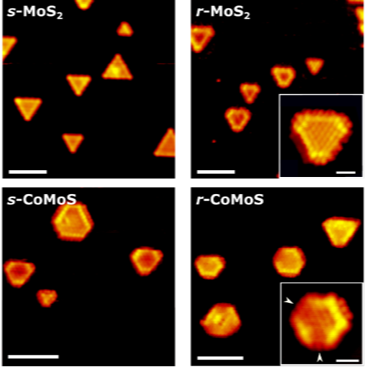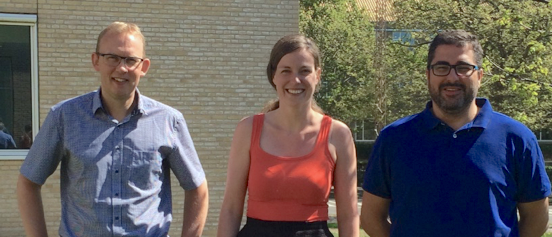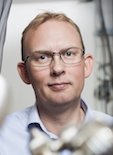Catalysts for Reduction of Sulphur Emissions under Pressure in Nature Communications
Strict regulations for Sulphur emissions call for improved catalytic processes of reducing Sulphur content in crude oil. A publication in Nature Communications by Jeppe Vang Lauritsen and Bjørk Hammer, Aarhus University, shine light on how MoS2-based catalysts are able to remove Sulphur.

The air quality in major cities persists to cause problems and will do so in the future as well. Consequently, there is a motivation for developing more efficient catalysts in order to decrease the harmful emissions from combustion in stationary and automotive applications. A new study from the Interdisciplinary Nanoscience Center (iNANO) and the Department of Physics and Astronomy, Aarhus University, within this topic has just been published in Nature Communications.
Molybdenum disulpfide (MoS2) -based catalysts have been used for several years to remove Sulphur from petroleum, but in order to make the catalytic process more efficient, there is still a need to know more about how the catalysts work. New results from iNANO reveal how the structure of MoS2-based catalysts is sensitive to the hydrogen pressure used under catalytic conditions.
Using a combination of surface science experiments and theoretical modelling, they find that MoS2 particle shapes change as a function of hydrogen pressure and that new catalytic sites are formed in this process. However, they also find that Cobalt (Co) has a stabilizing effect on the particles, which may explain why Co can be used in industry as a promoter of the MoS2-based catalysts. The findings link idealized model studies performed with scanning tunneling microscopy (STM) to the state of the important hydrodesulphurization catalyst under its working conditions and help us understand why the catalyst is suited for removal of Sulphur from crude oil.

From left: Jeppe Vang Lauritsen, Signe Strange Grønborg and Jonathan Rodriguez Fernandez (Photo: courtesy of Nanocatalysis Group)
This work was supported by the research project Clean-Air-Technologies by development of new catalysts (CAT-C), which is a collaboration between iNANO, Division of Synchrotron Radiation Research (SLF) and Haldor Topsøe, and is funded by Innovation Fund Denmark. The research within CAT-C focuses on facilitating development of better, more flexible and less expensive catalysts for waste gas treatment, emission control and fossil fuel refining, which are catalysts with a particularly high market potential due to the political and public focus on gas emissions.
The research has been carried out by researchers from Interdisciplinary Nanoscience Centre (iNANO) and Department of Physics and Astronomy at Aarhus University. Jeppe Vang Lauritsen, assoc. prof. at iNANO, and Bjørk Hammer, prof. at Department of Physics and Astronomy, have been in charge of the research team behind the study just published in the prestigious journal Nature Communications.
Visualizing hydrogen-induced reshaping and edge activation in MoS2 and Co-promoted MoS2 catalyst clusters. Signe S. Grønborg, Norberto Salazar, Albert Bruix, Jonathan Rodríguez-Fernández, Sean D. Thomsen, Bjørk Hammer & Jeppe V. Lauritsen*. doi: 10.1038/s41467-018-04615-9
For further information, please contact
(Photo: Lars Kruse, AU Communication) |
(Photo: Lars Kruse, AU Communication) |
Associate Professor Jeppe Vang Lauritsen Interdisciplinary Nanoscience Center Department of Physics and Astronomy Aarhus University Denmark Tel: +45 23382369 Email: jvang@inano.au.dk | Department of Physics and Astronomy Aarhus University Denmark Tel: +45 87155629 Email: hammer@phys.au.dk |
Assoc. Prof. Jeppe Vang Lauritsen has specialized in Non-contact Atomic Force Microscopy (AFM), Scanning Tunneling Microscope (STM), Photoemission Spectroscopy and Thermal desorption Spectroscopy for characterization as well as applying these powerful tools to achieve an atomic-scale understanding of which factors determine the specific catalytic properties of nanoparticles and nanostructures. Lauritsen is heading the Nanocatalysis Group at iNANO, Aarhus University. | Prof. Bjørk Hammer is a leading theorist in quantum mechanical calculations of surface properties, which he utilises to model the formation of chiral molecules over achiral solid surfaces. Hammer is heading the Theoretical Surface Science Group at Department of Physics and Astronomy, Aarhus University.
|


